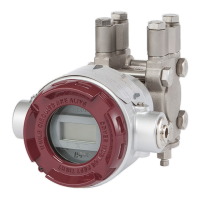A-13
Appendix A Maintenance and Troubleshooting of this Device
Note that whether or not the cause is clogging can be inferred by comparing the pressure frequency
index and the standard deviation with their values when conditions are normal. If the standard
deviation increases at the same time that the pressure frequency index decreases, it is probable that,
rather than a decrease in high-frequency fluctuation due to clogging, there has been an increase in
low-frequency fluctuation due to some other cause.
Whether or not the status in which only one side of the connecting pipe is clogged is detected
may vary depending on the various conditions such as fluid conditions or characteristics of the
differential pressure generation mechanism (orifice, etc.). To understand whether or not detection
is possible beforehand, it is strongly recommended that it is checked beforehand according to the
clogging simulation test stated in section A3-4-3.
Depending on materials that cause clogging, even when clogging occurs, variations in index are
small and no alarm is activated. For example, it is understood that when there are clearances,
even when a clogged state due to gravel exists, the pressure fluctuation is transmitted through the
clearances, and changes in index become small.
If the frequency of pressure fluctuation is abnormal from the beginning, as is a case where the
connecting pipe was clogged from the start, it may not be possible to diagnose the clogging. Do the
setup procedures (section A3-4) when the connecting pipe is operating normally.
Even if clogging occurs suddenly, the pressure frequency index will not change immediately. This
is because it takes a few minutes to calculate the frequency of the pressure fluctuation with a high
level of accuracy.
If the transmitter is installed in an environment subject to heavy vibration, the pressure frequency
index may be affected, preventing correct diagnosis.

